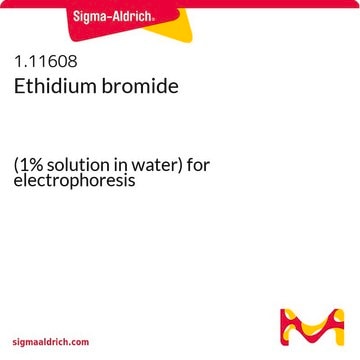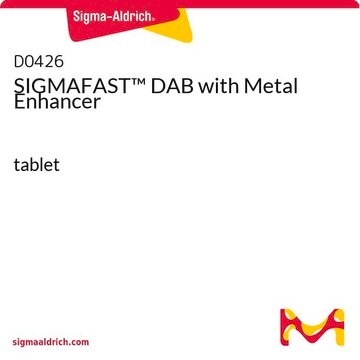Products may be shipped at a different temperature than the recommended long-term storage temperature. If the product quality is sensitive to short-term exposure to conditions other than the recommended long-term storage, it will be shipped on wet or dry-ice. If the product quality is NOT affected by short-term exposure to conditions other than the recommended long-term storage, it will be shipped at ambient temperature. As shipping routes are configured for minimum transit times, shipping at ambient temperature helps control shipping costs for our customers. For more information, please refer to the Storage and Transport Conditions document: https://www.sigmaaldrich.com/deepweb/assets/sigmaaldrich/marketing/global/documents/316/622/storage-transport-conditions-mk.pdf
E8751
Ethidium bromide
~95% (HPLC)
Sinónimos:
3,8-Diamino-5-ethyl-6-phenylphenanthridinium bromide, EtBr, Homidium bromide
Seleccione un Tamaño
41,60 €
Seleccione un Tamaño
About This Item
41,60 €
Productos recomendados
Ensayo
~95% (HPLC)
Nivel de calidad
mp
260-262 °C (dec.) (lit.)
cadena SMILES
[Br-].CC[n+]1c(-c2ccccc2)c3cc(N)ccc3c4ccc(N)cc14
InChI
1S/C21H19N3.BrH/c1-2-24-20-13-16(23)9-11-18(20)17-10-8-15(22)12-19(17)21(24)14-6-4-3-5-7-14;/h3-13,23H,2,22H2,1H3;1H
Clave InChI
ZMMJGEGLRURXTF-UHFFFAOYSA-N
¿Está buscando productos similares? Visita Guía de comparación de productos
Aplicación
Frameshift mutagen which intercalates double-stranded DNA and RNA.
Acciones bioquímicas o fisiológicas
Reconstitución
Producto relacionado
Palabra de señalización
Danger
Frases de peligro
Consejos de prudencia
Clasificaciones de peligro
Acute Tox. 1 Inhalation - Acute Tox. 4 Oral - Muta. 2
Código de clase de almacenamiento
6.1A - Combustible acute toxic Cat. 1 and 2 / very toxic hazardous materials
Clase de riesgo para el agua (WGK)
WGK 1
Punto de inflamabilidad (°F)
Not applicable
Punto de inflamabilidad (°C)
Not applicable
Equipo de protección personal
Eyeshields, Faceshields, Gloves, type P3 (EN 143) respirator cartridges
Elija entre una de las versiones más recientes:
¿Ya tiene este producto?
Encuentre la documentación para los productos que ha comprado recientemente en la Biblioteca de documentos.
Los clientes también vieron
Contenido relacionado
Ethidium bromide is a well-known and widely used fluorescent dye in biotechnology research.
-
How is shipping temperature determined? And how is it related to the product storage temperature?
1 respuesta-
¿Le ha resultado útil?
-
-
How can I determine the shelf life / expiration / retest date of this product?
1 respuesta-
If this product has an expiration or retest date, it will be shown on the Certificate of Analysis (COA, CofA). If there is no retest or expiration date listed on the product's COA, we do not have suitable stability data to determine a shelf life. For these products, the only date on the COA will be the release date; a retest, expiration, or use-by-date will not be displayed.
For all products, we recommend handling per defined conditions as printed in our product literature and website product descriptions. We recommend that products should be routinely inspected by customers to ensure they perform as expected.
For products without retest or expiration dates, our standard warranty of 1 year from the date of shipment is applicable.
For more information, please refer to the Product Dating Information document: https://www.sigmaaldrich.com/deepweb/assets/sigmaaldrich/marketing/global/documents/449/386/product-dating-information-mk.pdf¿Le ha resultado útil?
-
-
What is the Department of Transportation shipping information for this product?
1 respuesta-
Transportation information can be found in Section 14 of the product's (M)SDS.To access the shipping information for this material, use the link on the product detail page for the product.
¿Le ha resultado útil?
-
-
How can I make a stock solution of Product E8751, Ethidium bromide?
1 respuesta-
Ethidium bromide is soluble in water at 100 mg/mL. Per Crary, B. and Boyrsenko, M., Biotechniques, 4, 98-101 (1986), stock solutions of ethidium bromide in water or PBS are stable for at least two years at room temperature if protected from light.
¿Le ha resultado útil?
-
-
What is the best working concentration of Product E8751, Ethidium bromide?
1 respuesta-
For staining a gel after electrophoresis, dilute a sample of the stock solution to 0.5 μg/mL with water and incubate the gel for 15-30 min. Ethidium bromide can also be incorporated into the gel and running buffer at 0.5 μg/mL, and visualized immediately after electrophoresis.
¿Le ha resultado útil?
-
-
How can I dispose of solutions containing Product E8751, Ethidium bromide?
1 respuesta-
Ethidium bromide is mutagenic, and ultimately has to be destroyed by incineration. It can be removed from buffer solutions by several methods to reduce the volume of waste. See the product sheet for more details.
¿Le ha resultado útil?
-
Filtros activos
Nuestro equipo de científicos tiene experiencia en todas las áreas de investigación: Ciencias de la vida, Ciencia de los materiales, Síntesis química, Cromatografía, Analítica y muchas otras.
Póngase en contacto con el Servicio técnico








